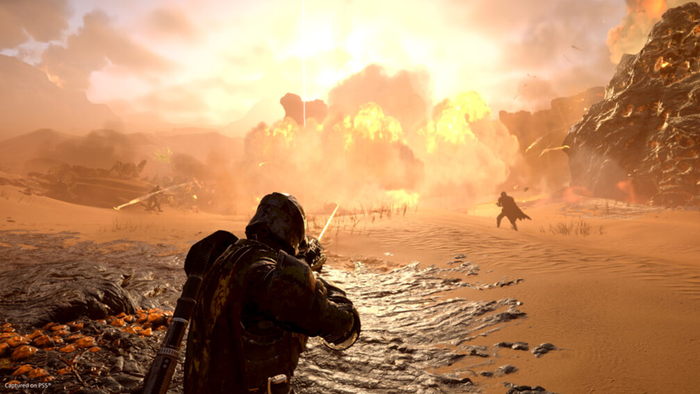
Featured Blog | This community-written post highlights the best of what the game industry has to offer. Read more like it on the Game Developer Blogs.
Global Success: The Role of a Live Ops Manager During Soft Launch
In this blog post you can find out what Live Ops Managers do during Softlaunch of a game at Square Enix Montreal.

Building for Global Success: The Role of a Live Ops Manager During Soft Launch
By David Molnar, Vito Minerva, Alysha Hum
Live Ops Blog Series
Building for Global Success: The Role of a Live Ops Manage during Soft Launch
Creating Personalized Player’s experience for maximum engagement
Live Ops play a key role in a game’s success once it is released worldwide. Today we’ll give you an overview of strategies, tools, processes, and pipelines that should be implemented in the months and years leading up to launch.
While a project is in Soft Launch, it's our responsibility to ensure that the game and the team is prepared for worldwide Launch. In this article, we’ll deepen your understanding of Live Ops and their role in a product’s development cycle.
More specifically, we’ll focus on:
How Live Ops Managers should take advantage of the Soft Launch period to set the table for long-term success
How testing plays a key role during Soft Launch
How Live Ops Managers should build and test game content and events for worldwide launches (and beyond!)
What Live Ops Managers do all day!
Live Ops Managers must think about all the future needs, not just the strategy for events and offers (although that is a big part of it), including:
How will we communicate with players?
What tools does the team need to prepare, not only to run events, but to react quickly and on-the-fly to the game’s performance and current events?
A Day in the Life…
For a Live Ops Manager, each day is different and filled with new and exciting challenges. Although there is no such thing as a typical day, here is what Live Ops Managers can expect during the Soft Launch phase of game development.
Coffee or beverage of choice – The day cannot start without it.
Learning – There’s always something new to learn whether from colleagues, competitors, conferences, videos, or books.
Checking the news – Keeping up with what’s trending in the mobile gaming and console landscape encourages innovation at the project and studio level.
Playing our games – Knowing our games inside and out and all their possibilities are essential to developing a concrete strategy for the future.
Meetings – Whether it’s a daily stand up meeting or all-employee studio meeting, checking in and socializing with team members is a must, especially in the era of working from home.
Reviewing KPIs – New numbers are always coming and we must stay on top of the latest data.
The Development Process during Tech and Soft Launch
During Soft Launch, our priority is improving player oriented KPIs, such as retention rates by developing, balancing and implementing features to prepare the product for a successful launch to a global audience.
But before the Soft Launch period begins, the game is first tested in Tech Launch.
Collect data on the game’s technical performances, such as crash rates.
Ensure that the game’s foundations are solid to evaluate whether we’re ready to begin further development.
Soft Launch in 3, 2, 1…Defining a Product Vision and Monitoring the Competition
So, what’s the role of Live Ops Managers in a game’s development process during Soft Launch? Let’s go into further details. When we are readying for Soft Launch, the team already has defined product vision: genre, sub genre, style, audiences, etc.
Monitoring and studying the Live Ops features of competitors (current and upcoming games) is key to the development process. It’s also important to study games that were once promising but did not live up to expectations to learn from their mistakes and make sure not to repeat them.
Allows the design and product teams to have a clear picture on what’s currently trending on the market.
Helps identify upcoming trends.
Monitoring the competition does not mean plagiarizing. Rather, it means understanding why certain mechanics work, how they can fit in our game, and how we can improve on them.
The Right Event, for the Right Player, at the Right Time
During Soft Launch, a selection of Live Ops events is collected based on the product vision. They are categorized by target audience, event length, and required engagement levels. Other unique factors such as virality can also come into play.
After the categorization is complete, we are left with the types of events that best support our product and those that would work best with the game’s current stage of development and the player journey. For example, the first live event that a player engages with cannot be an event that unlocks only after 30 days of gameplay. Obviously.
Once we have a portrait of the event types suited to our game and vision, they are pitched to the stakeholders — Creatives, Designers, and the Product team — to evaluate which events will engage with our players and how we can deliver a unique experience. If the team agrees to implement the event/feature, the design team will deliver the documentation that will be used by the programmers and artists for integration, and the QA team to ensure the feature has been integrated as originally designed. Balancing features is important to provide a seamless gameplay experience.
From a monetization perspective, this is a secondary issue in the early Soft Launch phase, but it becomes more important as we approach worldwide launch.
Test, Test, and Test Again!
In the previous blog post in this series, we discussed the essential tools and functionalities that are key to run Live Ops successfully in 2021. A key point was the importance of running A/B tests. When we develop a new feature or modify an existing one, we want to learn as much as possible.
Each update comes with new features and content that we believe our players will enjoy. Before releasing the update, the content is tested in secure environments that is only available to our development and QA teams.
During Soft Launch, the DAU (daily active users) is not as high as after worldwide launch, since the game is only available in certain countries or to a small group of players to playtest.
When we develop a new feature or modify an existing one, we want to learn as much as possible. A way of getting feedback from players is playtesting. Here are the major steps for successful testing:
The creative team proposes a change or integration of a new feature
Once the change is approved, we reach out to our user research team
In collaboration with the user research team, we develop a player survey (playtest)
When the playtest is completed, the user research team provides delivers the results
We can now decide whether to implement the feature
Live Ops managers configure event variables and collaborate with the QA team to ensure that the highest level of quality is reproduced in the game’s live environment.
User Acquisition
When an update with new features is released, we collaborate with the marketing team to acquire players through advertising campaigns on multiple platforms. Depending on the content and features, we might aim to grab the attention of different player types.
As we acquire new players through advertising campaigns, we analyze performance:
How players interact with the feature
Popularity of the new feature
Overall impact on the product
During Soft Launch, it’s crucial for Live Ops Managers to understand how players interact with the game, so a lot of time is spent on data analysis.
Never Stop Experimenting
No article about the day-to-day of Live Ops Managers would be complete without talking about experimentation. Constantly experimenting and iterating what you put in the game is just as important in the Soft Launch phase as at the time of worldwide launch, perhaps even more so.
We're not just talking about testing offers or button placement but also testing different iterations and versions of core features so that when you launch worldwide it is with the best possible version. Take the game's tutorial as an example: tweak it, swap some steps, or try completely different approaches altogether. Testing each new iteration will inform your decisions around it so you can have the best version possible for your players and meet your KPI targets.
To achieve this goal you must test, iterate features, and analyze the data:
Did the feature meet the targets you set for it?
How did the features affect major KPIs such as retention or monetization?
We begin by reviewing the data before diving deeper into the feature’s performance to find areas of improvement. We develop hypotheses based on findings. We brainstorm, plan and implement the changes, then rinse and repeat.
Experimentation is not just related to specific game features. Experimenting also means pushing the limits of the tech and tools that you've implemented to understand these limitations and find solutions before worldwide launch.
Segmentation
Segmentation is always an popular topic when it comes to Live Ops, but how is it different in Soft Launch compared to worldwide Launch? - During Soft Launch, you’ll have a smaller, narrower audience that you’ve acquired through user acquisition campaigns in targeted countries.
During this period, you might also be refining your audience:
Broad categories such as targeted countries
Specific categories such as age, gender, preferred game genre, and experience with specific games or genres.
Next come the motivations and drivers of the various player types within your audience. You’ll want to ensure that you provide a balance of features that appeal to these different types of players. Following worldwide launch, your audience will grow, and you’ll have more players to segment.
Flexibility and Creativity: The Live Ops Cycle and Process
Another important goal of a Live Ops Manager is understanding the Live Ops cycle. This means understanding types of events, their schedule, and the frequency at which the team needs to create new content to keep the players engaged.
Why is this so important?
If we understand what our Live Ops cycle will be, then we can simulate and test whether the content delivery frequency follows the Live Ops cycle, is feasible, and can be delivered over the game’s lifetime.
Soft Launch is the perfect time for Live Ops managers to plan event schedules and time their release for different regions.
Keep time zones in mind! A short event that scheduled at the same time worldwide may end up not being accessible to all players. - We also build a database of special occasions and holidays across the world to offer players special events that will resonate in their regions. Players appreciate the attention. The hype around major real-life events can also be leveraged as part of Live Ops. This requires plenty of planning to be executed smoothly.
But the Live Ops Cycle isn’t always smooth sailing.
What happens when things don’t go as planned, or something happens that you need to react to?
This is the time to make sure that we have the processes in place to run the Live Ops Cycle and are prepared to react when the time comes.
When an issue occurs in a live environment, can you react to it, and if so, how quickly?
When there's a major world event or trend takes off that you would like to include in your Live Ops content, is your process and content flexible enough for the quick turnaround?
In Soft Launch, we try to anticipate these kinds of scenarios, forecast our needs for the future, and test our pipelines and processes to make sure they work. As with everything in Live Ops, it’s all about experimenting and iterating so that we’re ready when we launch worldwide and the pressure is on!
Conclusion and Final Thoughts
We’d like to conclude by sharing what we think are the biggest challenges and the most exciting parts of Soft Launch.
Vito:
.jpg/?width=700&auto=webp&quality=80&disable=upscale)
“I’d say that one of the biggest challenges that a Live Ops team faces during the Soft Launch period is adapting your plan to the continuously evolving game to make sure that your strategy aligns with the finished product.
Throughout development, features and core elements can change drastically, which means that the Live Ops team needs to be adaptable and pivot their plan accordingly.
Inversely, the most exciting part about working on a project in Soft Launch is being a part of its entire evolution. As mentioned previously, because the core ideas of a game can change so much, things are put into perspective when you realize how far the team and game have grown. Whether it’s adding new mechanics, levels, and characters or building stronger relationships with colleagues, recognizing your progress from Day 1 to the present is important to be able to move forward and inspire.”

“One of the challenges of running Live Ops during Soft Launch is that you don't have all the tools or processes in place yet. You’re limited in what you can actually do Live at first.
There's a lot of time spent looking into what tools you need, weighing the pros and cons of the available options, and working with the team to set them up.
It's both exciting and a bit daunting since you want to make sure the choices you make now work both for the short and long term to avoid having to make a big tech change down the road.
The most exciting part though is seeing the game develop and grow from such an early stage and having a voice in its development. When something new is introduced or you change something, there's a lot of anticipation about how it will perform. Sometimes it doesn't work as well as planned, but you learn from it, investigate why, and work on suggestions and improvements to move forward.”

"Personally, I can’t pick only one exciting part! If I had to choose one, it would be the period when a new update is released (I'm sure many of the team members could agree with me).
Since so much effort goes into releasing an update, we eagerly await to receive data and feedback, including on forums and social media channels. Another exciting part of this phase is the continuous improvement of the build and the KPIs behind it.
Retention rates are an important metric that we track during Soft Launch, and the first few updates are about the FTUE (first-time user experience) completion rate, with the goal of reaching as close to 100% as possible.
Then, the next step is to develop and tweak the player’s journey after the FTUE. Slowly but surely, we switch the focus to long-term retention. Seeing the improvements of the product day-by-day is exciting!"
It was a pleasure for us to come together and create this blog post! Collaboration is one of the values that Square Enix Montréal prides itself on, especially during these challenging times when we are away from the Studio. This was a great opportunity to talk about our projects and processes. No matter where you are based, we recognize the importance of maintaining our professional and personal relationships.
There is one more post of the Square Enix Montréal Live Ops series, which will be about how we create personalized gameplay experience to maintain and increase player’s engagement.”
Read more about:
Featured BlogsAbout the Author(s)
You May Also Like













